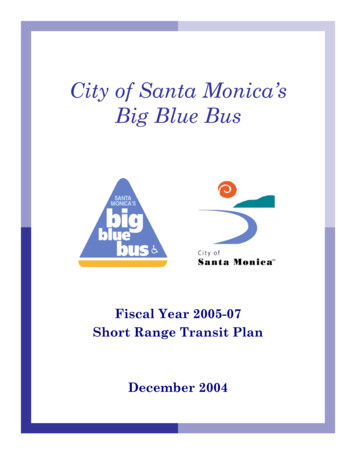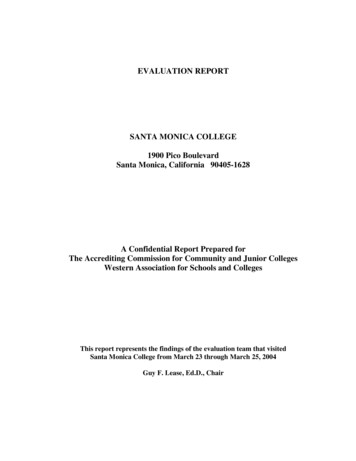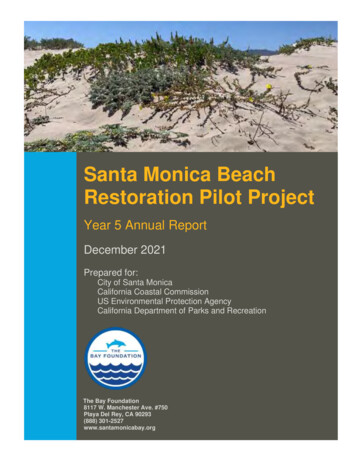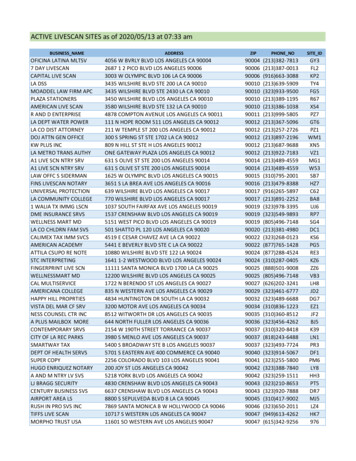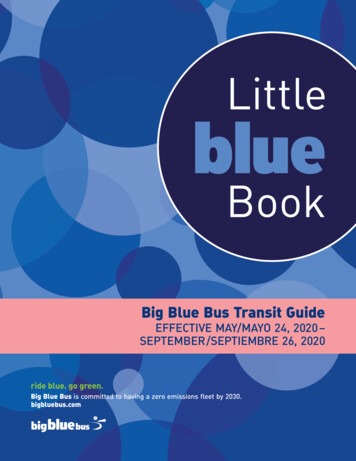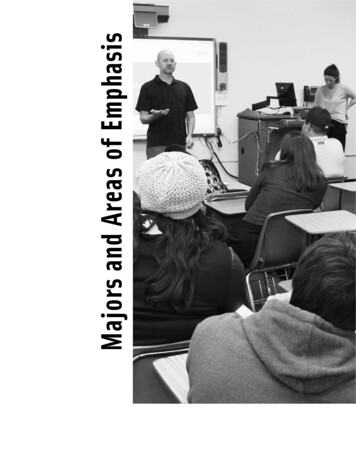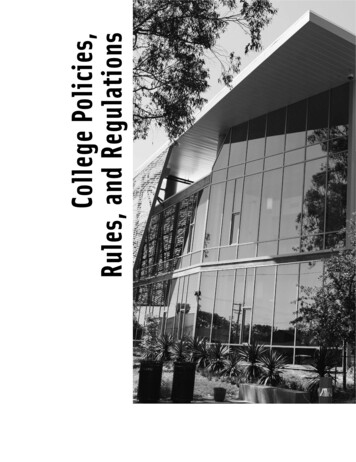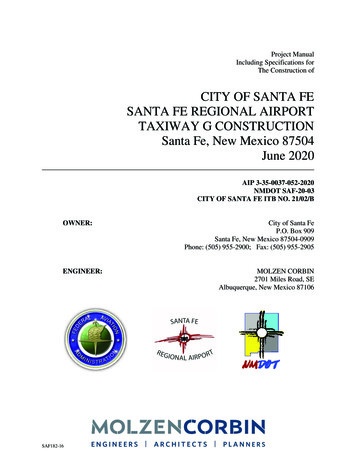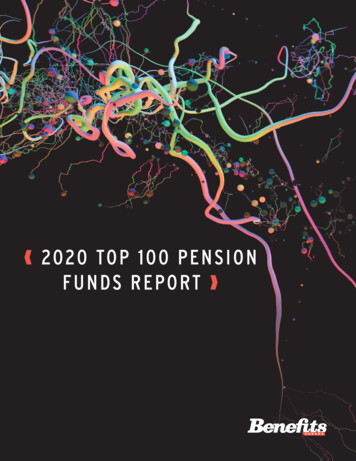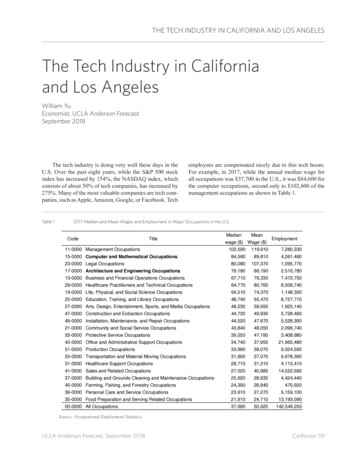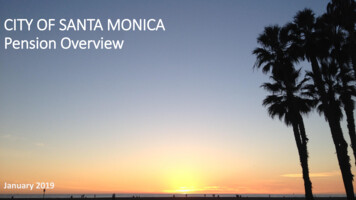
Transcription
CITY OF SANTA MONICAPension OverviewJanuary 2019
BackgroundThis presentation provides information on the City’s pension plan, including its structure, cost, andactions the City has taken to mitigate the impacts of ongoing pension costs and liability. The City of Santa Monica provides its permanent employees working more than 1,000 hours peryear for at least five years with a defined benefit retirement plan. Santa Monica pays for benefitsearned during an employee’s time in Santa Monica only. This plan is administered by CalPERS, the California Public Employee Retirement System. CalPERSserves the majority of California cities, counties and special districts and manages an investmentportfolio of 334.4 billion*. Santa Monica, like other cities, joined CalPERS in 1944. Specific retirement benefits arenegotiated with bargaining groups, based on a set of plans offered by CalPERS. According to a1955 State Supreme Court ruling, public employee pension benefits, once granted, cannot bemodified, even for future work. This is called the “California Rule;” currently under review inthree cases.* Market value 10/25/2018. Source: CalPERS
Santa Monica Employee Benefit (sworn)85% of 57Classic(hired before 7/1/2012)Tier 2(hired 7/1/2012-12/31/2012 or transferring toCity from another PERS plan)PEPRA(new to CalPERS and hired on/after 1/1/2013) How it works: payment to retiree years worked x rate x highest base salary* * highest year for Classic, avg of 3 highest consecutive years for Tier 2 and PEPRAWhy different tiers? The California Public Employees’ Pension Reform Act (PEPRA) created lower benefit levels for new employeesin all plans effective January 1, 2013. Before this, Santa Monica added a new, lower “Tier 2” for miscellaneous employees only. UnderTier 2, employees transferring from another CalPERS agency receive a lower benefit rate.Who has the new reduced plans? 1/3 of the City’s staff is currently under the Tier 2 and PEPRA Tiers.
What does the City pay?Annual Required Contribution Normal cost Unfunded Liability Normal cost: benefit earned during the year Unfunded liability: gap between value of prior contributions and cost of future payments.CalPERS factors in a portion of this to the City’s required annual contribution. Annualcontributions are sufficient to pay down the City’s unfunded liability over 30 years.Do employees contribute?Yes. Employees contribute up to 29% (depending on the plan/tier) of the total payment eachyear. Employees do not participate in Social Security, so this is their only retirement income.In FY 2017-18, the City’s portion of pension cost was approximately 49.4M (8% of the City’soperating budget) and employees paid 18.2M. The City’s payment included 24.6Mtoward unfunded liability.
Where does the money come from?Benefit payments come from employer contributions (what the City pays),employee contributions (what workers pay), and from CalPERS investment earnings.The graphic below demonstrates the breakdown.Source: CalPERS Newsroom 10/31/17
What is the story on pensions?Cities’ required CalPERS contributions have increased significantly since the GreatRecession and continue to grow, creating a big fiscal challenge for many cities. Theseincreases reflects CalPERS’ attempt to lower its unfunded liability (the gap between theassets it expects to have to make retiree payments, and the amount of assets it needs).The end goal is long-term sustainability.This a big change from the early and mid 2000s, when the CalPERS portfolio was relativelywell funded at over 80%; and at one point was superfunded, meaning that it had morethan 100% of the assets needed to cover all liabilities (retiree payments).Source: CalPERS
What about Santa Monica’s pensions?Santa Monica’s pension liability is 75% funded.Unfunded liability is calculated in two ways. Each incorporates assumption changesdifferently.CalPERS valuation Found in CalPERS actuarial valuationsState and Local GovernmentAccounting Reporting (GASB) Used in annual calculation of contributions Found in the City’s annual financial statements More updated participant data and assumptions(due to valuation timing) Used in reporting of liability Doesn’t show full phase in of discount ratedecreaseCurrent level: 438 M Includes full accounting of discount ratedecreaseCurrent level: 467 MFor 2018, Santa Monica will use the GASB number, 467 M. This is due toits more accurate consideration of the scheduled discount rate decrease.
CalPERS Rate of Return, Funded Ratio, Discount %-40.00%5.00%YearsRate of ReturnFunded LevelDiscount Rate
How did we get here?I: Structural Problems & Short-sighted DecisionsFor many years, strong market returns, optimistic assumptions, and less conservativemethodology hid system vulnerability until the 2008 market crash. Actions taken during this timefurther weakened fund health: In FY 1999-00, the State passed a law that greatly increased pension benefits without anassociated contribution increase (SB 400). Enhanced benefits were applied to past years worked (see example below) Benefits were based on highest year vs. 3-year average CalPERS underestimated costs and assumed continuing strong market returns In some years CalPERS did not require contributionsExample: An employee retiring on 12/31/99 (pre-SB400) received a 60,000 annual pension payment,while the same employee retiring on 1/1/2000 (post-SB400) received a 90,000 annual payment.In Santa Monica, non-public safety employees paid for enhanced benefits beginning in 2007.We’ve been increasing employee contributions since then.
How did we get here?II: External factors & responseMarket Performance. During the Great Recession, CalPERS experienced investment losses in linewith the market, including losses related to real estate and hedge fund positions. The outcome wasan over 30% loss in the portfolio’s value, which decreased the funding level (amount of liabilitiescovered by assets) to 61%.Assumption / Valuation Methodology Changes. Reacting to the lessons learned during the GreatRecession, CalPERS:1)2)3)4)Transitioned to a less risky, and therefore lower earning, portfolioAdjusted amortization/valuation methodologies. Transitioned from rolling to fixed 30 year amortizationperiod, from 15 year to 5 year smoothing period, and from actuarial to market valuation of assetsUpdated life expectancyChanged assumed return on investment first from 7.75%to 7.5%, and then from 7.5% to 7.0%These changes contributed to an increase in unfunded liability.
Rate of return 0.6%Impact: Unfundedliability: 19%Funded ratio: -4%Santa Monica Unfunded Liability & Contributing FactorsMarket value of assets; smoothing15 5 yrs; fixed 30 yr amortizationImpact: Unfunded liability: 49%;Funded ratio: .0Rate of return -24%Impact:Unfunded liability: 50%Funded ratio: -6%300.0250.090.0%19%75%70.0%50%50.0%Discount rate:7.75% 7.5%TIER 230.0%PEPRA200.050%10.0%150.0100.0-10.0%Rate of return Santa Monica Unfunded Liability( in M)2011-122012-132013-14Santa Monica Funded Ratio2014-152015-162016-17CalPERS Portfolio Rate of Return2017-18
How are we managing costs for the future?Payment strategies Prepayment. We prepay a portion of the City’s contribution at the startof the year, which entitles the City to an annual 0.9 million rebate. TheCity has saved about 11.5 million from this strategy through FY 2017-18,which it then uses for additional pay downs of the unfunded liability. Voluntary Additional Payments (beyond the required annualcontribution): To help lower unfunded liability, we’ve used savings to paydown 77.5 million towards unfunded liability through FY 2017-18,including a 45 million paydown on June 13, 2017. These paydowns areestimated to produce over 6 million in annual contribution savings. Ourfiscal policy requires us to make additional paydowns of at least 1.3million annually.Employee contributions & Lower cost benefit plans Tier 2 & PEPRA. New and transferring Santa Monica employees areeligible for a lower pension benefit than Classic members. Employees are contributing more towards retirement.
How are we managing costs for the future?Future changes CalPERS recently voted to shorten amortization periods for future gainsand losses to 20 years, helping to reduce negative amortization (whenyour contribution isn’t sufficient to pay even annual interest amounts)and decrease total costs. These changes will take effect in FY 2021-22. Consider using future year savings to further pay down unfundedliability or establish a rate stabilization fund that will shield the budgetfrom rate fluctuations.
How do plan costs compare?Employee TypeRetirementBudget / FTE*Sworn Police 64,000Sworn Fire 59,000Non-Safety (Misc.) 19,000*Average budgeted cost in FY 2018-19 per FTE. Net of employee contribution.
How do these look in the City’s budget?% Total FTE byEmployee Type% Total Budget byEmployee 25.3%30.0%20.0%10.0%10.3%12.5%5.5%0.0%Sworn FireSworn PoliceAll non-Sworn
How can I look this up?The amounts are included in retirement line items. You can find this in:The City’s operating budget Using the City’s online data review tool, Open Gov
How to view City retirement costs with Open GovThe table shows seven years ofretirement spending and budget bydepartment. 61.4 MHow to get here:santamonicaca.opengov.comSelect:Operating BudgetExpense Type Salaries and WagesDepartments All except non-DepartmentalSpecific Expense Types:
Where can I find more information?Budget Staff Reports Recent activity: See the June 13, 2017 report on Payment TowardsUnfunded Pension Liability Ongoing: search Council agendas for Budget staff’s biannual financialstatus updates to Council.Comprehensive Annual Financial Report View information in the notes to financial statements, and other areasthroughout the document. The City’s annual financial report reports pension liabilities on itsstatement of net position. This is a result of new accounting rules(GASB 68) meant to improve reporting. The detailed information is inNote 16.Questions? Email budget@smgov.net
The City of Santa Monica provides its permanent employees working more than 1,000 hours per year for at least five years with a defined benefit retirement plan. Santa Monica pays for benefits earned during an employee's time in Santa Monica only. This plan is administered by CalPERS, the California Public Employee Retirement System. CalPERS

